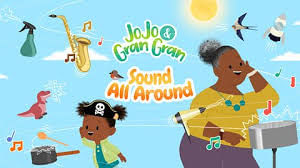Class 2 Exam > Class 2 Notes > Year 2 English IGCSE (Cambridge) > Chapter Notes: All about sounds
All about sounds Chapter Notes | Year 2 English IGCSE (Cambridge) - Class 2 PDF Download
| Table of contents |

|
| Introduction to Sounds |

|
| Types of Sounds |

|
| How Sounds are Made |

|
| How Sound Travels |

|
| How We Hear Sounds |

|
| Making Your Own Vibrations |

|
Introduction to Sounds
Listening to Sounds
- Close your eyes and listen. What do you hear?
- Sounds are all around us all the time.
- Some sounds are loud and unpleasant, like traffic, which we call noise.
- Sounds made by instruments, like a piano or a ukulele, are called notes.
- Lots of notes together make music.
Types of Sounds
- Noise
- Loud and unpleasant sounds.
- Example: Traffic noise.
- Notes and Music
- Sounds made by musical instruments.
- Example: Notes from a piano or a ukulele.
- Onomatopoeia
- Words that sound like the sounds they describe.
- Examples: Fireworks go "boom," popcorn "pops," bells "dingling."

Question for Chapter Notes: All about soundsTry yourself: What do we call loud and unpleasant sounds like traffic?View Solution
How Sounds are Made
Vibrations
- All sounds are made through vibrations.
- When something vibrates, it moves back and forth really fast.
- Our eyes often can't see vibrations, but our ears can sense them.
How Sound Travels
- Air Particles
- The air is made up of tiny particles.
- These particles carry sound.
- Sound Waves
- Vibrations from a sound source (like a bell) shake the air particles.
- These particles bump into the particles next to them, passing the vibration along like a wave.
- Example: Rolling a marble into a group of marbles to demonstrate how particles move.
How We Hear Sounds
Inside Our Ears
- There is a part of our ear that looks like the top of a drum.
- Sound waves make this part of our ear vibrate.
- The vibrations move deeper into our ear, sending a message to our brain that says, "Hey, we're hearing something."
Question for Chapter Notes: All about soundsTry yourself: How do sound waves travel through the air?View Solution
Making Your Own Vibrations
- DIY Musical Instrument
- Materials: An empty can (like a coffee can) and a rubber band.
- Stretch the rubber band over the top of the can.
- Pluck the rubber band gently to make a sound.
- If you look closely, you can see the rubber band moving back and forth, creating vibrations.
- Experimenting with Sounds
- Gently plucking the rubber band makes a soft sound.
- Pulling the rubber band harder makes a louder sound.
- Stopping the rubber band from vibrating stops the sound.
Examples and Activities
- Listening Activity: Close your eyes and identify different sounds around you. Are they noise, notes, or onomatopoeic sounds?
- Marble Experiment: Use marbles to show how particles in the air move to carry sound. Roll a marble into a group of marbles and watch them move.
- DIY Instrument: Make your own rubber band instrument and experiment with different sounds by plucking the rubber band gently or harder.
Conclusion
Understanding Vibrations
- Whenever you hear a sound, something is vibrating.
- These vibrations travel through the air and into your ears.
The document All about sounds Chapter Notes | Year 2 English IGCSE (Cambridge) - Class 2 is a part of the Class 2 Course Year 2 English IGCSE (Cambridge).
All you need of Class 2 at this link: Class 2
|
5 videos|13 docs|1 tests
|
FAQs on All about sounds Chapter Notes - Year 2 English IGCSE (Cambridge) - Class 2
| 1. What are the different types of sounds? |  |
Ans. The different types of sounds include musical sounds, environmental sounds, speech sounds, and animal sounds.
| 2. How are sounds made? |  |
Ans. Sounds are made when an object vibrates, causing the air particles around it to vibrate and create sound waves.
| 3. How does sound travel? |  |
Ans. Sound travels in waves through a medium, such as air, water, or solids. The speed of sound varies depending on the medium it is traveling through.
| 4. How do we hear sounds? |  |
Ans. We hear sounds when sound waves enter our ear and vibrate our eardrum. The vibrations are then converted into electrical signals that are sent to the brain for interpretation.
| 5. How can you make your own vibrations to create sounds? |  |
Ans. You can make your own vibrations to create sounds by using objects that can vibrate, such as a drum, guitar strings, or vocal cords. When these objects vibrate, they produce sound waves that can be heard.
Related Searches




















